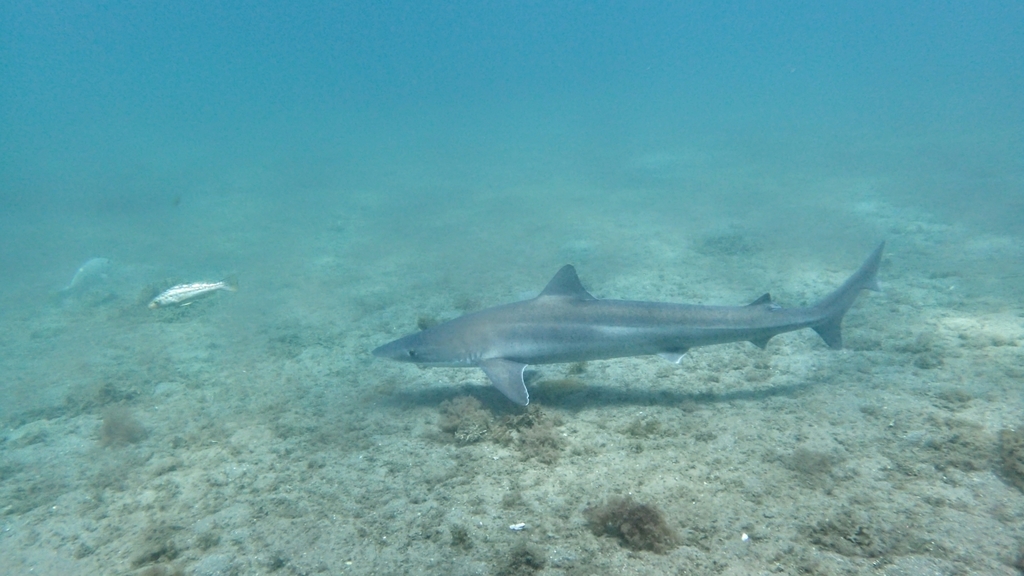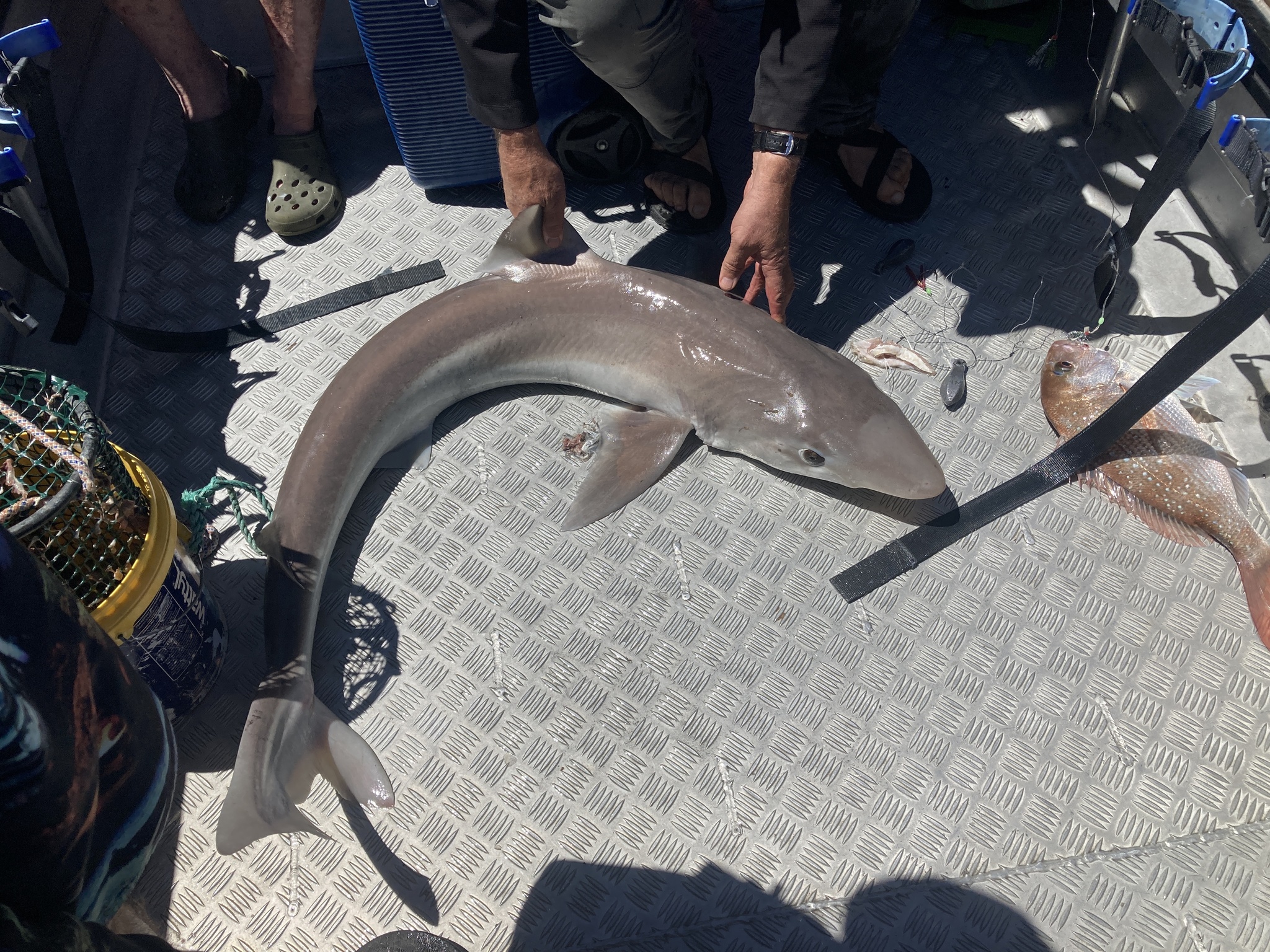Galeorhinus galeus
North Coast (Oregon Border to Point Arena)
North Central Coast (South of Point Arena to Half Moon Bay)
Central Coast (South of Half Moon Bay to Point Conception)
Santa Barbara (Point Conception to Point Dume)
South Coast (Point Dume to Mexico border)
Firm fish
Oily fish
Wild caught
The Science

Taxonomic description
- Most notably recognized by a pointed, long snout and overall slender appearance. [7]
- A key identifying feature of soupfin shark is a second dorsal fin located above its anal fin. [7]
- Mostly dark grey in color with a white underside. [10]
- Averages around 1.8 meters (6 feet), in length. [3]
Distribution
- Found worldwide in the Atlantic, Indian, and Pacific oceans. [10]
- In California, range depends on the sex; females typically stay in the Southern California region [3]; Males typically range from Northern California to British Columbia. [3]
- Ranges overlap in Central California where an equal ratio of females and males can be found. [3]
Life history
- Maximum known life span is 55 years. [10]
- Spawns once a year during the early summer and is ovoviviparous, where the eggs develop in mother’s body until ready to hatch. [10]
- Following a one-year gestation period, a female shark will give birth to litters ranging from 6-52 pups. [10]
- Nurseries are often in shallow waters during the summer then move to deep coastal waters during the winter. [10]
Habitat
- Typically found in cold and temperate waters at the bottom of shallow water bays, canyons, and offshore ecosystems. [8]
- Preys on invertebrates and bony fishes. [8]
- Predators of soupfin sharks include great white sharks, spotted sevengill sharks, and most likely larger marine mammals. [8]
The Fishery

Seasonal availability
- Commercial fishing of the Soupfin shark is open year-round. [12]
- Though commercial fishing operations occur all year, landings of the soupfin shark are greatest between September and December. [12]
Regulatory and managing authority
- The fishery for this shark is managed federally by the NOAA fisheries and, as established by the Magnuson-Stevens Act, the Pacific Fishery Management Council (PFMC) through the Pacific Coast Groundfish Fishery Management Plan (FMP) as an Ecosystem Component Species. [4]
- As established by the Marine Life Management Act, the California Fish and Game Commission (CFGC) regulates the fishery in state waters, and the California Department of Fish and Wildlife (CDFW) manages this fishery. [13]
Gear type
- Fishing gear used to catch this fish include drift gill-net and saltwater trolling. [12]
Status of the fishery
- In the 1930s, soupfin shark was heavily overfished as a rich source of Vitamin A oil and eventually collapsed in the 1940s; local populations are currently considered vulnerable. [7,10]
- Populations today are not well-studied, this species has not yet recovered to pre-1930 numbers and is an area of concern. [8]
- Under the Pacific Coast Groundfish FMP, a “rockfish conservation area” closes large areas to fishing of sharks or groundfish by most types of fishing gear; FMP also implements annual harvest guidelines for sustainable fishing. [4]
Potential ecosystem impacts
- Fishing in Southern California during Spring may harm recovering populations since pregnant females and juveniles reside in that area. [8]
The Seafood

Edible portions
- Meat of the shark, fins, liver (good source of vitamin A oil). [5]
Description of meat
- The meat is white, firm, juicy. [6]
Culinary uses
- It is obtained fresh or frozen, skinned in fillets or steaks, or dried and salted.
- Fins are commonly used in shark fin soup, and the meat is mostly cooked/grilled in steaks. [5]
Nutritional information
- Nutritional information for Soupfin shark could not be found; shown is a fillet of spiny dogfish shark (both species are groundfish). [1,2]
Toxicity report
- All sharks have concentrations of urea, a non-toxic byproduct from its metabolic process that degrades to ammonia, and therefore must be gutted promptly and prepared properly (see prep reference at FAO). [5]
- Sharks caught in other regions have higher levels of mercury, but no information can be found for the California fishery specifically. [8]
Seasonal availability
- Available year-round. [9]
References
[1] My fitness pal. 2017 Calories in Freshly Caught Spiny Dogfish Shark. Web. https://www.myfitnesspal.com/food/calories/spiny-dogfish-shark-546201216. Accessed 24 May 2017.
[2] New York Seafood Council. Cape Shark (Spiny Dogfish), skinless, baked, no added fat, salt, or sauce. Web. https://www.eatthismuch.com/food/view/cape-shark-spiny-dogfish-skinless-baked-no-added-f,532525/. Accessed 18 May 2017.
[3] Birch Aquarium Blog, 2014. Meet the Locals: Soupfin Sharks. Web. https://aquarium.ucsd.edu/blog/meet-the-locals-soupfin-sharks/. Accessed 12 April 2017.
[4] Pacific Fishery Management Council. n.d. Fishery management plan and amendments. Web. https://www.pcouncil.org/groundfish-fishery-management-plan-and-amendments/. Accessed 14 Sept 2020.
[5] Fisheries and Aquaculture Department. Shark Utilization, Marketing and Trade. Web. http://www.fao.org/docrep/005/x3690e/x3690e0o.htm. Accessed 12 April 2017.
[6] Shaw, H. 2010. The Great White Delicacy. Web. https://www.theatlantic.com/health/archive/2010/08/the-great-white-delicacy/61016/. Accessed 1 May 2017.
[7] Oceanscape Aquarium. Soupfin Shark. Web. https://www.oceanscape-aquarium.org/soupfin-shark.html. Accessed 12 April 2017.
[8] Fisheries and Aquaculture Department Species Fact Sheets: Galeorhinus galeus.. Web. http://www.fao.org/fishery/species/2828/en. Accessed 16 April 2017.
[9] California Department of Fish and Wildlife Summary of Recreational Groundfish Fishing Regulations for 2017.. Web. https://www.wildlife.ca.gov/Fishing/Ocean/Regulations/Groundfish-Summary#south. Accessed 23 May 2017.
[10] MarineBio Conservation Society Tope Sharks, Galeorhinus galeus.. Web. https://marinebio.org/species/tope-sharks/galeorhinus-galeus/. Accessed 16 April 2017.
[11] West's Annotated California Codes, Fish and Game Code, Division 3. Fish and Game Generally, Chapter 1. Taking and Possessing in General, § 2021. Shark fins; unlawful possession, sale, offer for sale, trading, or distribution; exceptions. Web. https://www.animallaw.info/statute/ca-sharks-%C2%A7-2021-shark-fins-unlawful-possession-sale-offer-sale-trading-or-distribution. Accessed 17 May 2017.
[12] Holts, David B. "Review of US west coast commercial shark fisheries." Marine Fisheries Review 50.1 (1988): 1-8. Web. https://spo.nmfs.noaa.gov/marine-fisheries-review/mfr-501-1988. Accessed 14 Sept 2020.
[13] Marine Life Management Act. n.d. California Department of Fish and Wildlife. Web. https://wildlife.ca.gov/Conservation/Marine/MLMA. Accessed 24 August 2020.
[14] Duffy, C. iNaturalist. 2008. Digital image. Web. https://www.inaturalist.org/photos/4244534. Accessed 25 February 2021.
[15] Fieber, A. iNaturalist. 2017. Digital image. Web. https://www.inaturalist.org/photos/9854365. Accessed 25 February 2021.
[16] benknight. iNaturalist. 2021. Digital image. Web. https://www.inaturalist.org/photos/111660780. Accessed 25 February 2021.
[17] Gonzalez, J. flickr. 2010. Shark. Digital image. Web. https://flickr.com/photos/macabrephotographer/4457993522. Accessed 25 February 2021.
